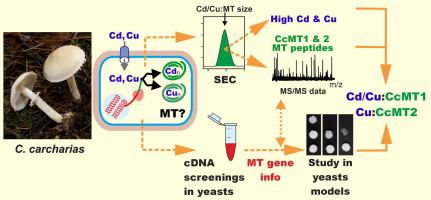Fungal Genetics and Biology ( IF 2.4 ) Pub Date : 2021-05-18 , DOI: 10.1016/j.fgb.2021.103574 Jan Sácký 1 , Jiří Černý 1 , Jiří Šantrůček 1 , Jan Borovička 2 , Tereza Leonhardt 1 , Pavel Kotrba 1

|
Cystoderma carcharias is one of the few macrofungal species that can hyperaccumulate Cd. As we have previously documented in C. carcharias collected from a smelter-polluted area, it stores 40% of Cd and nearly 90% of Cu in sporocarps in complex(es) of identical size. In this paper we examined whether metallothionein (MT) peptides that bind Cd and Cu through cysteinyl-thiolate bonds were associated with the metals in these complexes. Screening of a sporocarp cDNA expression library in yeasts allowed the identification of two transcripts, CcMT1 and CcMT2, encoding functional 34-amino acid (AA) MTs sharing 56% identity and appearing to be encoded by duplicate genes. CcMT1 conferred reasonable tolerance to Cu and a substantially higher tolerance to Cd than CcMT2, while CcMT2 clearly protected the yeasts better against Cu toxicity. While size-exclusion chromatography revealed that CcMT1 was contained in all Cd/Cu complexes isolated from wild grown sporocarps, CcMT2 was detected in a much narrower subset of the fractions. The striking difference between the CcMTs is that CcMT1 lacks the third metal-biding cysteinyl (C) within an otherwise highly conserved-in-agaricomycetes-MTs C-AA4-C-AA-C-AA3-C-AA-C-AA4-C-AA-C motif. The elimination of the corresponding cysteinyl in CcMT2 only reduced the Cu-tolerant phenotype in yeasts to the levels observed with CcMT1. Altogether, these results indicate that CcMT2 is rather adjusted to perform Cu-related tasks and point to CcMT1 as the ligand for the storage of both Cd and Cu in C. carcharias, which is the first macrofungal species in which the potential of MT in Cd handling can be seen.
中文翻译:

镉超积累蘑菇 Cystoderma carcharias 有两种金属硫蛋白亚型,可用于镉和铜的储存
Cystoderma carcharias是少数可以超积累 Cd 的大型真菌物种之一。正如我们之前在从冶炼厂污染区域收集的C. carcharias 中所记录的那样,它在相同大小的复合体中储存了 40% 的 Cd 和近 90% 的 Cu。在本文中,我们检查了通过半胱氨酰-硫醇盐键结合 Cd 和 Cu 的金属硫蛋白 (MT) 肽是否与这些复合物中的金属相关。在酵母中筛选孢子果 cDNA 表达文库可以鉴定两个转录本,Cc MT1和 Cc MT2,编码功能性 34 氨基酸 (AA) MT,具有 56% 的同一性并且似乎由重复基因编码。抄送MT1赋予酵母合理的铜耐受性和比 Cc MT2显着更高的 Cd 耐受性,而 Cc MT2显然更好地保护酵母免受铜毒性。虽然尺寸排阻色谱显示 CcMT1 包含在从野生生长的孢子果中分离的所有 Cd/Cu 复合物中,但在更窄的部分子集中检测到 CcMT2。CcMTs 之间的显着区别在于 CcMT1 缺乏第三个金属结合半胱氨酰 (C),否则高度保守的伞形菌-MTs C-AA 4 -C-AA-C-AA 3 -C-AA-C- AA 4 -C-AA-C 图案。消除 Cc MT2 中相应的半胱氨酰仅将酵母中的 Cu 耐受表型降低到 Cc 观察到的水平MT1。总而言之,这些结果表明 CcMT2 更适合执行与 Cu 相关的任务,并指出 CcMT1 作为在C. carcharias 中储存 Cd 和 Cu 的配体,这是第一个在 Cd 中具有 MT 潜力的大型真菌物种处理可见。







































 京公网安备 11010802027423号
京公网安备 11010802027423号